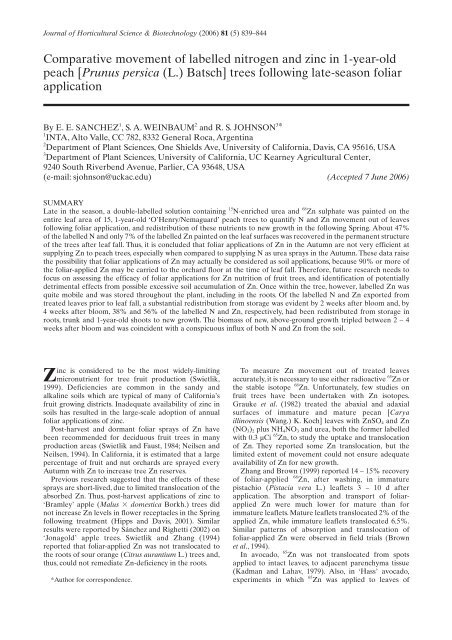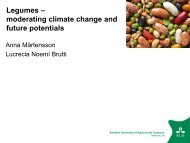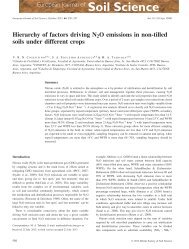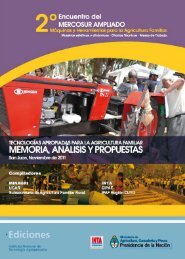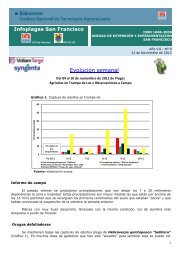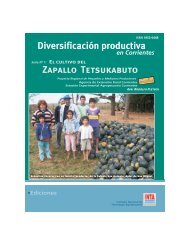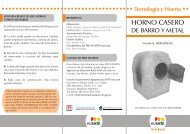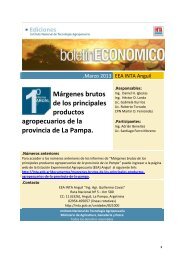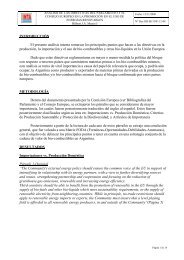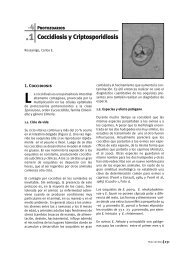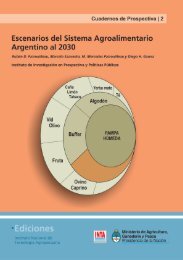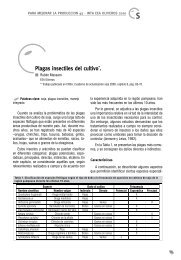Comparative movement of labelled nitrogen and zinc in 1 ... - INTA
Comparative movement of labelled nitrogen and zinc in 1 ... - INTA
Comparative movement of labelled nitrogen and zinc in 1 ... - INTA
Create successful ePaper yourself
Turn your PDF publications into a flip-book with our unique Google optimized e-Paper software.
Journal <strong>of</strong> Horticultural Science & Biotechnology (2006) 81 (5) 839–844<br />
<strong>Comparative</strong> <strong>movement</strong> <strong>of</strong> <strong>labelled</strong> <strong>nitrogen</strong> <strong>and</strong> <strong>z<strong>in</strong>c</strong> <strong>in</strong> 1-year-old<br />
peach [Prunus persica (L.) Batsch] trees follow<strong>in</strong>g late-season foliar<br />
application<br />
By E. E. SANCHEZ 1 , S. A. WEINBAUM 2 <strong>and</strong> R. S. JOHNSON 3 *<br />
1 <strong>INTA</strong>, Alto Valle, CC 782, 8332 General Roca, Argent<strong>in</strong>a<br />
2 Department <strong>of</strong> Plant Sciences, One Shields Ave, University <strong>of</strong> California, Davis, CA 95616, USA<br />
3 Department <strong>of</strong> Plant Sciences, University <strong>of</strong> California, UC Kearney Agricultural Center,<br />
9240 South Riverbend Avenue, Parlier, CA 93648, USA<br />
(e-mail: sjohnson@uckac.edu) (Accepted 7 June 2006)<br />
SUMMARY<br />
Late <strong>in</strong> the season, a double-<strong>labelled</strong> solution conta<strong>in</strong><strong>in</strong>g 15 N-enriched urea <strong>and</strong> 68 Zn sulphate was pa<strong>in</strong>ted on the<br />
entire leaf area <strong>of</strong> 15, 1-year-old ‘O’Henry/Nemaguard’ peach trees to quantify N <strong>and</strong> Zn <strong>movement</strong> out <strong>of</strong> leaves<br />
follow<strong>in</strong>g foliar application, <strong>and</strong> redistribution <strong>of</strong> these nutrients to new growth <strong>in</strong> the follow<strong>in</strong>g Spr<strong>in</strong>g. About 47%<br />
<strong>of</strong> the <strong>labelled</strong> N <strong>and</strong> only 7% <strong>of</strong> the <strong>labelled</strong> Zn pa<strong>in</strong>ted on the leaf surfaces was recovered <strong>in</strong> the permanent structure<br />
<strong>of</strong> the trees after leaf fall. Thus, it is concluded that foliar applications <strong>of</strong> Zn <strong>in</strong> the Autumn are not very efficient at<br />
supply<strong>in</strong>g Zn to peach trees, especially when compared to supply<strong>in</strong>g N as urea sprays <strong>in</strong> the Autumn. These data raise<br />
the possibility that foliar applications <strong>of</strong> Zn may actually be considered as soil applications, because 90% or more <strong>of</strong><br />
the foliar-applied Zn may be carried to the orchard floor at the time <strong>of</strong> leaf fall. Therefore, future research needs to<br />
focus on assess<strong>in</strong>g the efficacy <strong>of</strong> foliar applications for Zn nutrition <strong>of</strong> fruit trees, <strong>and</strong> identification <strong>of</strong> potentially<br />
detrimental effects from possible excessive soil accumulation <strong>of</strong> Zn. Once with<strong>in</strong> the tree, however, <strong>labelled</strong> Zn was<br />
quite mobile <strong>and</strong> was stored throughout the plant, <strong>in</strong>clud<strong>in</strong>g <strong>in</strong> the roots. Of the <strong>labelled</strong> N <strong>and</strong> Zn exported from<br />
treated leaves prior to leaf fall, a substantial redistribution from storage was evident by 2 weeks after bloom <strong>and</strong>, by<br />
4 weeks after bloom, 38% <strong>and</strong> 56% <strong>of</strong> the <strong>labelled</strong> N <strong>and</strong> Zn, respectively, had been redistributed from storage <strong>in</strong><br />
roots, trunk <strong>and</strong> 1-year-old shoots to new growth. The biomass <strong>of</strong> new, above-ground growth tripled between 2 – 4<br />
weeks after bloom <strong>and</strong> was co<strong>in</strong>cident with a conspicuous <strong>in</strong>flux <strong>of</strong> both N <strong>and</strong> Zn from the soil.<br />
Z<strong>in</strong>c is considered to be the most widely-limit<strong>in</strong>g<br />
micronutrient for tree fruit production (Swietlik,<br />
1999). Deficiencies are common <strong>in</strong> the s<strong>and</strong>y <strong>and</strong><br />
alkal<strong>in</strong>e soils which are typical <strong>of</strong> many <strong>of</strong> California’s<br />
fruit grow<strong>in</strong>g districts. Inadequate availability <strong>of</strong> <strong>z<strong>in</strong>c</strong> <strong>in</strong><br />
soils has resulted <strong>in</strong> the large-scale adoption <strong>of</strong> annual<br />
foliar applications <strong>of</strong> <strong>z<strong>in</strong>c</strong>.<br />
Post-harvest <strong>and</strong> dormant foliar sprays <strong>of</strong> Zn have<br />
been recommended for deciduous fruit trees <strong>in</strong> many<br />
production areas (Swietlik <strong>and</strong> Faust, 1984; Neilsen <strong>and</strong><br />
Neilsen, 1994). In California, it is estimated that a large<br />
percentage <strong>of</strong> fruit <strong>and</strong> nut orchards are sprayed every<br />
Autumn with Zn to <strong>in</strong>crease tree Zn reserves.<br />
Previous research suggested that the effects <strong>of</strong> these<br />
sprays are short-lived, due to limited translocation <strong>of</strong> the<br />
absorbed Zn. Thus, post-harvest applications <strong>of</strong> <strong>z<strong>in</strong>c</strong> to<br />
‘Bramley’ apple (Malus domestica Borkh.) trees did<br />
not <strong>in</strong>crease Zn levels <strong>in</strong> flower receptacles <strong>in</strong> the Spr<strong>in</strong>g<br />
follow<strong>in</strong>g treatment (Hipps <strong>and</strong> Davis, 2001). Similar<br />
results were reported by Sánchez <strong>and</strong> Righetti (2002) on<br />
‘Jonagold’ apple trees. Swietlik <strong>and</strong> Zhang (1994)<br />
reported that foliar-applied Zn was not translocated to<br />
the roots <strong>of</strong> sour orange (Citrus aurantium L.) trees <strong>and</strong>,<br />
thus, could not remediate Zn-deficiency <strong>in</strong> the roots.<br />
*Author for correspondence.<br />
To measure Zn <strong>movement</strong> out <strong>of</strong> treated leaves<br />
accurately, it is necessary to use either radioactive 65 Zn or<br />
the stable isotope 68 Zn. Unfortunately, few studies on<br />
fruit trees have been undertaken with Zn isotopes.<br />
Grauke et al. (1982) treated the abaxial <strong>and</strong> adaxial<br />
surfaces <strong>of</strong> immature <strong>and</strong> mature pecan [Carya<br />
ill<strong>in</strong>oensis (Wang.) K. Koch] leaves with ZnSO4 <strong>and</strong> Zn<br />
(NO3) 2 plus NH 4NO 3 <strong>and</strong> urea, both the former <strong>labelled</strong><br />
with 0.3 µCi 65 Zn, to study the uptake <strong>and</strong> translocation<br />
<strong>of</strong> Zn. They reported some Zn translocation, but the<br />
limited extent <strong>of</strong> <strong>movement</strong> could not ensure adequate<br />
availability <strong>of</strong> Zn for new growth.<br />
Zhang <strong>and</strong> Brown (1999) reported 14 – 15% recovery<br />
<strong>of</strong> foliar-applied 68 Zn, after wash<strong>in</strong>g, <strong>in</strong> immature<br />
pistachio (Pistacia vera L.) leaflets 3 – 10 d after<br />
application. The absorption <strong>and</strong> transport <strong>of</strong> foliarapplied<br />
Zn were much lower for mature than for<br />
immature leaflets. Mature leaflets translocated 2% <strong>of</strong> the<br />
applied Zn, while immature leaflets translocated 6.5%.<br />
Similar patterns <strong>of</strong> absorption <strong>and</strong> translocation <strong>of</strong><br />
foliar-applied Zn were observed <strong>in</strong> field trials (Brown<br />
et al., 1994).<br />
In avocado, 65 Zn was not translocated from spots<br />
applied to <strong>in</strong>tact leaves, to adjacent parenchyma tissue<br />
(Kadman <strong>and</strong> Lahav, 1979). Also, <strong>in</strong> ‘Hass’ avocado,<br />
experiments <strong>in</strong> which 65 Zn was applied to leaves <strong>of</strong>
840<br />
greenhouse-grown seedl<strong>in</strong>gs showed that less than 1% <strong>of</strong><br />
the Zn applied as ZnSO 4 or as Zn metalosate was<br />
absorbed by the leaf tissue.<br />
In apples, studies us<strong>in</strong>g both un<strong>labelled</strong> Zn <strong>and</strong> the<br />
stable isotope, 68 Zn, demonstrated that neither dormant<br />
nor Autumn applications contributed significantly to the<br />
Zn content <strong>of</strong> newly-develop<strong>in</strong>g tissues <strong>in</strong> the Spr<strong>in</strong>g<br />
(Sánchez <strong>and</strong> Righetti, 2002). However, Spr<strong>in</strong>g<br />
applications <strong>of</strong> Zn affected only those leaves contacted,<br />
<strong>and</strong> very little Zn moved from the sprayed leaves to new<br />
organs.<br />
Thus, it appears that foliar-applied Zn is rather<br />
immobile. The fact that symptoms <strong>of</strong> Zn deficiency are<br />
clearly visible <strong>in</strong> new growth is consistent with the<br />
limited mobility <strong>of</strong> Zn applied to mature foliage. Thus,<br />
the efficacy <strong>of</strong> Zn application will depend on the<br />
percentage <strong>of</strong> tree leaf area that receives the Zn spray,<br />
<strong>and</strong> on the physiological age <strong>of</strong> the foliage exposed.<br />
Up to now, no attempts have been made to quantify<br />
the amount <strong>of</strong> Zn delivered to storage tissues after foliar<br />
application, or to assess the portion <strong>of</strong> the storage pool <strong>of</strong><br />
Zn that is remobilised <strong>in</strong>to new growth the follow<strong>in</strong>g<br />
Spr<strong>in</strong>g. In contrast to Zn, the relatively high N-use<br />
efficiency <strong>of</strong> foliar urea sprays has been welldocumented<br />
<strong>in</strong> many fruit species (We<strong>in</strong>baum, 1988;<br />
Rosecrance et al., 1998;Tagliav<strong>in</strong>i et al., 1998;Toselli et al.,<br />
2004). However, an assessment <strong>of</strong> N-recovery <strong>in</strong> the<br />
follow<strong>in</strong>g season, after a late season application <strong>of</strong> urea,<br />
has not been quantified under orchard conditions <strong>in</strong> any<br />
fruit tree species.<br />
Our objectives were (i) to quantify the <strong>movement</strong> <strong>of</strong> N<br />
<strong>and</strong> Zn out <strong>of</strong> leaves follow<strong>in</strong>g foliar application; (ii) to<br />
quantify the distribution <strong>of</strong> N <strong>and</strong> Zn <strong>in</strong> the permanent<br />
structures <strong>of</strong> the dormant tree; <strong>and</strong> (iii) to quantify the<br />
redistribution <strong>of</strong> foliar-applied N <strong>and</strong> Zn from the tree<br />
structure to new growth <strong>in</strong> the follow<strong>in</strong>g Spr<strong>in</strong>g. The<br />
relative contribution <strong>of</strong> the <strong>movement</strong> <strong>of</strong> foliar-applied<br />
Zn to the storage pool should permit a more quantitative<br />
perspective on the value <strong>of</strong> foliar applications <strong>of</strong> Zn.<br />
MATERIALS AND METHODS:<br />
In Spr<strong>in</strong>g 2003, dormant, nursery-grown peach trees <strong>of</strong><br />
cv. ‘O’Henry/Nemaguard’ were planted <strong>in</strong> a s<strong>and</strong>y loam<br />
soil <strong>of</strong> the Hanford series (typic xerothents) at the<br />
University <strong>of</strong> California Kearney Agricultural Center,<br />
Parlier, California (36°48’ N, 119°30’ W). The trees were<br />
tra<strong>in</strong>ed to a Kearney Perpendicular “V” system (DeJong<br />
et al., 1994) with two ma<strong>in</strong> scaffolds. All shoots not<br />
aris<strong>in</strong>g from the scaffolds were removed <strong>in</strong> late Summer.<br />
On 11 September 2003, five replicates <strong>of</strong> three uniform<br />
trees that had grown to a height <strong>of</strong> approx. 1.5 m were<br />
selected for treatment.<br />
Ten ml <strong>of</strong> a ZnSO4 solution conta<strong>in</strong><strong>in</strong>g 68 Zn (99.4<br />
Atom % 68 Zn) at 1 mg ml –1 plus 15 N-<strong>labelled</strong> urea (10.8<br />
Atom % 15 N) at 2% (w/v) was applied with a small pa<strong>in</strong>t<br />
brush to the adaxial leaf surface <strong>of</strong> the entire canopy on<br />
each <strong>of</strong> the 15 trees. Before application, the trunks <strong>and</strong><br />
soil were covered with plastic to prevent contam<strong>in</strong>ation<br />
by <strong>labelled</strong> Zn <strong>and</strong> N from the treated leaves, although<br />
care was taken to prevent the <strong>labelled</strong> solution from<br />
dripp<strong>in</strong>g or runn<strong>in</strong>g-<strong>of</strong>f the leaves. As the trees were still<br />
grow<strong>in</strong>g, a second application <strong>of</strong> 3 ml per tree, mostly to<br />
the new growth, was made on 29 October 2003, follow<strong>in</strong>g<br />
Foliar application <strong>of</strong> <strong>labelled</strong> N <strong>and</strong> Zn <strong>in</strong> peach<br />
the same procedure. A total <strong>of</strong> 13 ml per tree was thus<br />
applied <strong>in</strong> two applications. Senescent leaves were<br />
collected on tarpaul<strong>in</strong>s placed under the trees <strong>and</strong><br />
subsequently removed from the orchard to avoid any<br />
possible contam<strong>in</strong>ation. Dur<strong>in</strong>g dormancy (16 January<br />
2004), one tree from each replicate was excavated <strong>and</strong><br />
separated <strong>in</strong>to roots, trunk <strong>and</strong> shoots. Backhoe trenches<br />
2.0 m deep were dug 1.5 m from the trunk <strong>and</strong> the soil<br />
around the roots was removed with a pitchfork. We<br />
estimated ≥ 90% recovery <strong>of</strong> root biomass. The two<br />
rema<strong>in</strong><strong>in</strong>g trees <strong>in</strong> each replicate were excavated on two<br />
dates <strong>in</strong> Spr<strong>in</strong>g 2004. All trees were left unpruned<br />
between the time <strong>of</strong> Zn/N application <strong>and</strong> excavation, to<br />
m<strong>in</strong>imise variation between trees <strong>and</strong> to maximise the<br />
recovery <strong>of</strong> both isotopes. The first Spr<strong>in</strong>g excavation<br />
was on 22 March, 2 weeks after full bloom, <strong>and</strong> the<br />
second excavation was on 5 April, approx. 4 weeks after<br />
full bloom. In both Spr<strong>in</strong>g excavations, the trees were<br />
divided <strong>in</strong>to roots, trunk, shoots <strong>and</strong> new growth.<br />
Trunks were cut at the graft union, <strong>and</strong> roots were<br />
washed with water at the excavation site. After tissue<br />
separation, all fresh materials was taken to the laboratory<br />
<strong>and</strong> washed. Tissues were cut <strong>in</strong>to smaller pieces to<br />
facilitate dry<strong>in</strong>g, placed <strong>in</strong> paper bags, dried at 60°C for at<br />
least 48 h, <strong>and</strong> ground to pass a 40-mesh screen. Dry<br />
tissue (0.5 g) was digested us<strong>in</strong>g a nitric acid-hydrogen<br />
peroxide microwave digestion to produce a liquid sample<br />
for total Zn <strong>and</strong> N isotope analysis (Sah <strong>and</strong> Miller, 1992).<br />
Sample analysis<br />
Digested plant samples were analysed us<strong>in</strong>g an<br />
Agilent Technologies 7500c ICP-MS (Agilent<br />
Technologies, Palo Alto, CA, USA). The Zn isotopes<br />
measured were 64, 66, 67, 68 <strong>and</strong> 70. Each isotope was<br />
monitored for 900 ms with a total <strong>of</strong> ten replicates per<br />
analysis. Yttrium (0.5 µg l –1 ) was added as an <strong>in</strong>ternal<br />
st<strong>and</strong>ard to each blank, each calibration st<strong>and</strong>ard, <strong>and</strong><br />
each plant sample. Calibration reference Zn st<strong>and</strong>ards<br />
(SPEX CertiPrep, Metuchen, NJ, USA) ranged from 5 ng<br />
ml –1 to 5 µg ml –1 total Zn (Zhang <strong>and</strong> Brown, 1999).<br />
To calculate isotopic concentrations, the ion <strong>in</strong>tensities<br />
<strong>of</strong> each Zn isotope were first st<strong>and</strong>ardised with the signal<br />
<strong>of</strong> the <strong>in</strong>ternal st<strong>and</strong>ard. The abundance <strong>of</strong> each isotope<br />
was then determ<strong>in</strong>ed by normalis<strong>in</strong>g each Zn isotope<br />
ratio to the total amount <strong>of</strong> Zn measured <strong>in</strong> the sample.<br />
Isotopic concentrations were calculated us<strong>in</strong>g calibration<br />
curves for each Zn isotope <strong>and</strong> the abundance <strong>of</strong> that<br />
isotope <strong>in</strong> the sample. The enrichment <strong>of</strong> 68 Zn was<br />
evaluated us<strong>in</strong>g the 68 Zn/ 67 Zn ratio, which was calculated<br />
us<strong>in</strong>g the ion <strong>in</strong>tensities (Zhang <strong>and</strong> Brown, 1999).<br />
St<strong>and</strong>ard solutions were analysed throughout the<br />
sample run <strong>and</strong> used to apply a mass discrim<strong>in</strong>ation<br />
correction factor to all samples. This correction factor<br />
was the ratio <strong>of</strong> the measured 68 Zn/ 67 Zn ratio to the<br />
theoretical ratio, <strong>and</strong> ranged from 0.9944 – 1.0249.<br />
The amount <strong>of</strong> Zn derived from the <strong>labelled</strong> fertiliser<br />
was calculated from the equation based on the isotope<br />
ratio modified from Ziegler et al. (1989), described <strong>in</strong><br />
detail by Zhang <strong>and</strong> Brown (1999).<br />
Nitrogen isotope composition was determ<strong>in</strong>ed by<br />
mass spectrometry. Atom percentage values <strong>of</strong> 15 N were<br />
converted to N derived from the <strong>labelled</strong> fertiliser us<strong>in</strong>g<br />
st<strong>and</strong>ard conversions (Hauck <strong>and</strong> Bremer, 1976).<br />
Results for dry mass (DM) <strong>and</strong> the distribution <strong>of</strong>
TABLE I<br />
Biomass distribution (g DW tree –1 ) among organs <strong>of</strong> trees sampled dur<strong>in</strong>g<br />
dormancy (16 January), 2 weeks after full bloom (22 March) <strong>and</strong> 1 month<br />
after full bloom (5 April)<br />
Organ January 16 March 22 April 5<br />
New Growth – 112.8 ± 22.6 339.4 ± 34.9<br />
Shoots 292.0 ± 39.9 a<br />
total <strong>and</strong> <strong>labelled</strong> Zn <strong>and</strong> N are reported as means ±<br />
st<strong>and</strong>ard deviation for all components. Percentage<br />
distributions <strong>of</strong> total <strong>and</strong> <strong>labelled</strong> Zn <strong>and</strong> N for each<br />
tissue <strong>and</strong> sampl<strong>in</strong>g date were analysed by the paired<br />
Student’s t test. Percentage values were arcs<strong>in</strong><br />
transformed before statistical analysis. Recovery <strong>of</strong> Zn<br />
<strong>and</strong> N was calculated as a percentage <strong>of</strong> the total<br />
application <strong>of</strong> 68 Zn <strong>and</strong> 15 N isotopes.<br />
RESULTS<br />
Almost 55% <strong>of</strong> the total DM <strong>of</strong> dormant, 1-year-old<br />
trees corresponded to roots, 18% to the trunk, <strong>and</strong> 27%<br />
to shoots (Table I). Two weeks after full bloom (22<br />
March 2004), the second batch <strong>of</strong> trees was excavated,<br />
<strong>and</strong> the total tree weights had not <strong>in</strong>creased over the 65 d<br />
s<strong>in</strong>ce the previous, dormant season excavation (Table I).<br />
The ma<strong>in</strong> difference <strong>in</strong> DM distribution between the first<br />
<strong>and</strong> second excavated trees was <strong>in</strong> the roots. Roots, as a<br />
percentage <strong>of</strong> tree DM, decreased from 55% dur<strong>in</strong>g<br />
dormancy to about 45% <strong>and</strong> 34%, 2 weeks <strong>and</strong> 4 weeks<br />
after full bloom, respectively. As new growth <strong>in</strong>creased,<br />
tree DM <strong>in</strong>creased by approx. 20% between dormancy<br />
<strong>and</strong> 1 month after full bloom (Table I).<br />
Total N content <strong>in</strong>creased from 15 g to 26 g per tree<br />
between dormancy <strong>and</strong> 1 month follow<strong>in</strong>g full bloom.<br />
Total Zn content <strong>in</strong>creased from 11 mg to 20 mg per tree<br />
dur<strong>in</strong>g the same period (Table II). Most <strong>of</strong> the uptake <strong>of</strong><br />
N <strong>and</strong> Zn from the soil between dormancy <strong>and</strong> 4 weeks<br />
after full bloom occurred over the 2 week period from<br />
E. E. SANCHEZ,S.A.WEINBAUM <strong>and</strong> R. S. JOHNSON<br />
223.8 ± 7.1 310.0 ± 41.3<br />
Trunk 199.2 ± 54.6 204.0 ± 26.3 210.2 ± 30.0<br />
Roots 603.4 ± 81.0 437.8 ± 23.2 442.4 ± 81.7<br />
Whole Tree 1094.6 ± 145.5 978.4 ± 130.4 1302.0 ± 140.4<br />
a<br />
Values are means ± SD. (n = 5 trees).<br />
841<br />
2 – 4 weeks after bloom. The roots <strong>of</strong> dormant trees<br />
conta<strong>in</strong>ed 70% <strong>and</strong> 41% <strong>of</strong> total tree N <strong>and</strong> Zn contents<br />
respectively, at the time when roots comprised 55% <strong>of</strong><br />
the tree biomass (Table III).<br />
In the second excavation, 2 weeks after bud break (22<br />
March), the total N <strong>and</strong> Zn contents per tree rema<strong>in</strong>ed<br />
relatively unchanged from the levels determ<strong>in</strong>ed<br />
previously <strong>in</strong> dormant trees. The fact that, <strong>in</strong> these trees,<br />
new growth conta<strong>in</strong>ed 34% <strong>and</strong> 38% <strong>of</strong> the total pool <strong>of</strong><br />
N <strong>and</strong> Zn, respectively, 2 weeks after bud break (Table<br />
III), <strong>in</strong>dicates the substantial <strong>in</strong>tra-tree redistribution <strong>of</strong><br />
nutrients that occurs dur<strong>in</strong>g this period.<br />
Recovery <strong>of</strong> <strong>labelled</strong> N <strong>and</strong> Zn applied to trees varied<br />
from 45.3 – 49.2% <strong>and</strong> from 6.8 – 7.9%, respectively<br />
(Table IV). These data did not <strong>in</strong>clude the 15 N <strong>and</strong> 68 Zn<br />
reta<strong>in</strong>ed <strong>in</strong> senescent leaves, as our aim was to quantify<br />
the amount <strong>of</strong> foliar-applied nutrient translocated from<br />
leaves to storage <strong>in</strong> perennial parts <strong>of</strong> the tree over the<br />
W<strong>in</strong>ter.<br />
Both elements were translocated throughout the trees<br />
after application. Sixty-five percent <strong>of</strong> the <strong>labelled</strong> N, <strong>and</strong><br />
42% <strong>of</strong> the <strong>labelled</strong> Zn were found <strong>in</strong> roots dur<strong>in</strong>g<br />
dormancy (Table V). Two weeks after full bloom, 24% <strong>of</strong><br />
the <strong>labelled</strong> N <strong>and</strong> 45.5% <strong>of</strong> the <strong>labelled</strong> Zn had been<br />
translocated to new growth <strong>and</strong>, by 4 weeks after full<br />
bloom (5 April), the storage pool had contributed 38%<br />
<strong>and</strong> 55.9% <strong>of</strong> N <strong>and</strong> Zn, respectively, to the new growth.<br />
A strik<strong>in</strong>g quantitative difference was apparent between<br />
the two nutrients <strong>in</strong> their re-translocation from storage<br />
to new growth. Roots remobilised 30% <strong>of</strong> stored N to the<br />
new growth, <strong>and</strong> 79% <strong>of</strong> stored Zn (Table IV). As a<br />
result, the amount <strong>of</strong> <strong>labelled</strong> N <strong>in</strong> roots decreased from<br />
65% to 43.8% <strong>of</strong> the tree total, <strong>and</strong> <strong>labelled</strong> Zn<br />
decreased from 42% to 7.7% <strong>of</strong> the tree total 1 month<br />
after full bloom (Table V).<br />
DISCUSSION<br />
Previous studies apply<strong>in</strong>g 68 Zn to a s<strong>in</strong>gle leaf or group<br />
<strong>of</strong> leaves <strong>in</strong> fruit trees have suggested limited mobility<br />
(Zhang <strong>and</strong> Brown, 1999; Sánchez <strong>and</strong> Righetti, 2002).<br />
TABLE II<br />
Total tree N (g N tree –1 ) <strong>and</strong> Zn (mg Zn tree –1 ) distributions among different organs <strong>of</strong> trees sampled dur<strong>in</strong>g dormancy (16 January), 2 weeks after full<br />
bloom (22 March) <strong>and</strong> 1 month follow<strong>in</strong>g full bloom (5 April)<br />
January 16 March 22 April 5<br />
Organ N Zn N Zn N Zn<br />
New Growth – – 5.70 ± 1.21 4.55 ± 0.86 14.93 ± 1.60 11.32 ± 0.98<br />
Shoots 3.30 ± 0.44 a<br />
4.51 ± 0.78 1.82 ± 0.55 2.95 ± 1.26 2.15 ± 0.24 4.26 ± 0.50<br />
Trunk 1.20 ± 0.35 2.27 ± 0.75 0.89 ± 0.16 1.95 ± 0.79 0.85 ± 0.14 2.13 ± 0.66<br />
Roots 10.79 ± 1.95 4.66 ± 0.36 8.24 ± 0.49 2.69 ± 0.39 7.94 ± 1.29 2.11 ± 0.49<br />
Whole Tree 15.29 ± 2.50 11.44 ± 1.78 16.65 ± 2.05 12.13 ± 2.75 25.87 ± 2.49 19.83 ± 2.26<br />
a<br />
Values are means ± SD (n = 5).<br />
TABLE III<br />
Percentage distribution <strong>of</strong> total tree N <strong>and</strong> Zn among different organs <strong>of</strong> trees sampled dur<strong>in</strong>g dormancy (16 January), 2 weeks after full bloom<br />
(22 March) <strong>and</strong> 1 month after full bloom (5 April)<br />
January 16 March 22 April 5<br />
Organ N Zn Sig. N Zn Sig. N Zn Sig.<br />
New Growth – – – 34.0 ± 3.5 37.9 ± 3.1 NS 57.7 ± 2.71 57.3 ± 2.0 NS<br />
Shoots 21.8 ± 2.3 a<br />
39.4 ± 2.8 ** b<br />
10.7 ± 2.1 23.6 ± 5.6 ** 8.4 ± 1.1 21.5 ± 1.8 **<br />
Trunk 7.8 ± 1.9 19.5 ± 3.2 ** 5.4 ± 0.6 15.8 ± 4.3 ** 3.3 ± 0.5 10.6 ± 2.6 **<br />
Roots 70.4 ± 2.2 41.1 ± 3.9 ** 49.9 ± 5.3 22.7 ± 4.0 ** 30.6 ± 3.6 10.6 ± 1.5 **<br />
Whole Tree 100.0 100.0 100.0 100.0 100.0 100.0<br />
a<br />
Values are means ± SD (n = 5).<br />
b<br />
NS, **, non-significant, or significant at P ≤ 0.01, respectively, by paired t test.
842<br />
However, such studies could not simulate complete foliar<br />
application, <strong>in</strong> which all leaves, shoots <strong>and</strong> trunk <strong>of</strong> the<br />
tree are treated, nor quantify the percentage<br />
redistribution <strong>of</strong> Zn <strong>and</strong> N from over-W<strong>in</strong>ter storage to<br />
new growth the follow<strong>in</strong>g Spr<strong>in</strong>g. Furthermore, no<br />
previous studies on fruit trees have identified the parts<br />
which serve as sites <strong>of</strong> for Zn deposition over W<strong>in</strong>ter<br />
On the other h<strong>and</strong>, the dynamics <strong>of</strong> uptake <strong>of</strong> foliar N<br />
by trees has been widely reported (Rosecrance et al.,<br />
1998; Tagliav<strong>in</strong>i et al., 1998; We<strong>in</strong>baum, 1988). Thus<br />
<strong>in</strong>clusion <strong>of</strong> <strong>labelled</strong> N <strong>in</strong> the applications allowed us to<br />
compare N with Zn, to ga<strong>in</strong> better <strong>in</strong>formation on their<br />
comparative partition<strong>in</strong>g to storage organs, their<br />
redistribution after the resumption <strong>of</strong> growth <strong>in</strong> Spr<strong>in</strong>g,<br />
<strong>and</strong> identification <strong>of</strong> probable source organs for nutrient<br />
allocation <strong>in</strong>to new growth.<br />
By treat<strong>in</strong>g the entire canopy, we were able to quantify<br />
the amounts <strong>and</strong> percentages <strong>of</strong> <strong>labelled</strong> N <strong>and</strong> Zn<br />
applied to leaves that were translocated out prior to leaf<br />
abscission. Between 45.3 – 49.2% <strong>of</strong> N, <strong>and</strong> 6.7 – 7.8% <strong>of</strong><br />
Zn was recovered <strong>in</strong> the trees after leaf fall. The 15 N <strong>and</strong><br />
68 Zn recovered <strong>in</strong> new Spr<strong>in</strong>g growth had been foliarly<br />
applied the previous Autumn, stored dur<strong>in</strong>g the W<strong>in</strong>ter,<br />
<strong>and</strong> remobilised <strong>in</strong> the Spr<strong>in</strong>g. These data should be<br />
considered as the m<strong>in</strong>imum percentage redistribution <strong>of</strong><br />
N <strong>and</strong> Zn from storage organs to new growth, because<br />
our experiment was term<strong>in</strong>ated 4 weeks after full bloom.<br />
We cannot rule out the possibility <strong>of</strong> additional nutrient<br />
redistribution from storage if the experiment had been<br />
extended <strong>in</strong>to the grow<strong>in</strong>g season .<br />
Us<strong>in</strong>g 15 N-<strong>labelled</strong> urea, Tagliav<strong>in</strong>i et al. (1998)<br />
demonstrated 58 – 69% absorption <strong>of</strong> the urea-N<br />
<strong>in</strong>tercepted by the canopies <strong>of</strong> nectar<strong>in</strong>e [Prunus persica<br />
(L.) Batsch var. nectar<strong>in</strong>a] trees. We did not analyse<br />
senescent leaves, but recognise that additional recovery<br />
<strong>of</strong> foliar-applied N <strong>in</strong> these leaves was likely, as complete<br />
export <strong>of</strong> urea-N prior to leaf senescence was not<br />
anticipated. Other studies have shown N recovery rates<br />
<strong>in</strong> the permanent structure <strong>of</strong> the tree <strong>of</strong> 50% or better<br />
after an Autumn foliar application <strong>of</strong> 15 N-<strong>labelled</strong> urea<br />
Foliar application <strong>of</strong> <strong>labelled</strong> N <strong>and</strong> Zn <strong>in</strong> peach<br />
TABLE IV<br />
Distribution <strong>of</strong> <strong>labelled</strong> N <strong>and</strong> Zn (mg tree –1 ) among different organs <strong>of</strong> trees sampled dur<strong>in</strong>g dormancy (16 January), 2 weeks after full bloom<br />
(22 March) <strong>and</strong> 1 month after full bloom (5 April), <strong>and</strong> percentage recovery <strong>of</strong> total isotope applied<br />
January 16 March 22 April 5<br />
Organ N Zn N Zn N Zn<br />
New Growth – – 13.01 ± 1.78 0.397 ± 0.06 22.30 ± 1.87 0.568 ± 0.069<br />
Shoots 13.58 ± 1.02 a<br />
0.425 ± 0.053 7.56 ± 2.7 0.232 ± 0.072 7.28 ± 0.06 0.296 ± 0.04<br />
Trunk 6.31 ± 1.74 0.107 ± 0.03 4.24 ± 0.94 0.081 ± 0.017 3.32 ± 0.31 0.073 ± 0.022<br />
Roots 37.22 ± 4.02 0.385 ± 0.027 29.38 ± 1.14 0.166 ± 0.028 26.0 ± 5.39 0.079 ± 0.017<br />
Whole Tree 57.11 ± 4.84 0.918 ± 0.074 54.19 ± 5.89 0.876 ± 0.137 59.89 ± 6.58 1.016 ± 0.100<br />
RECOVERY (%) 47.75 ± 4.05 7.10 ± 0.57 45.31 ± 4.93 6.78 ± 1.06 49.24 ± 5.50 7.86 ± 0.78<br />
a<br />
Values are means ± SD (n = 5).<br />
(We<strong>in</strong>baum, 1988; Rosecrance et al., 1998).<br />
In the present study, we were unable to determ<strong>in</strong>e how<br />
much <strong>of</strong> the <strong>labelled</strong> Zn deposited on the leaf surfaces<br />
was actually absorbed by the leaves. Nevertheless, 7 – 8%<br />
transport is approx. the same percentage translocation as<br />
has been reported <strong>in</strong> other crops (Boaretto et al., 1998;<br />
Ferr<strong>and</strong>on <strong>and</strong> Chamel, 1988; Zhang <strong>and</strong> Brown, 1999).<br />
Some workers have even reported less than 1%<br />
translocation (Boaretto et al., 2002; Volschenk et al.,<br />
1999). Presumably, Zn transport levels less than 10%<br />
might be considered the maximum that can be achieved<br />
with st<strong>and</strong>ard sprays <strong>of</strong> ZnSO4. There are significant<br />
barriers to the absorption <strong>of</strong> foliar-applied Zn. Zn can be<br />
adsorbed to the cuticle <strong>and</strong>/or cell walls (Ferr<strong>and</strong>on <strong>and</strong><br />
Chamel, 1988), or sequestered <strong>in</strong> an <strong>in</strong>soluble form<br />
(Zhang <strong>and</strong> Brown, 1999) <strong>and</strong> thus made unavailable for<br />
transport.<br />
Partition<strong>in</strong>g <strong>of</strong> N to the root system <strong>in</strong> Autumn, for<br />
storage dur<strong>in</strong>g the W<strong>in</strong>ter, is well-documented <strong>in</strong><br />
perennial trees (Sánchez et al., 1992; Millard, 1996), but<br />
no similar data on Zn are available <strong>in</strong> the literature.<br />
Sixty-five percent <strong>of</strong> the recovered, <strong>labelled</strong> N was<br />
transported to the roots <strong>in</strong> this experiment (Table V).<br />
Although not as much as N, 42% <strong>of</strong> the recovered 68 Zn<br />
was found <strong>in</strong> dormant roots (Table V), suggest<strong>in</strong>g good<br />
mobility <strong>of</strong> the small amount <strong>of</strong> leaf-absorbed Zn <strong>in</strong><br />
peach trees. This contrasts with citrus, where several<br />
studies have shown limited <strong>movement</strong> <strong>of</strong> foliarly-applied<br />
Zn to roots (Swietlik, 2002a, b).<br />
In the Spr<strong>in</strong>g, trees had remobilised approx. 24% <strong>of</strong><br />
their 15 N <strong>and</strong> 45.5% <strong>of</strong> their 68 Zn for new growth 2 weeks<br />
after full bloom. By the end <strong>of</strong> the experiment, 4 weeks<br />
after full bloom, remobilisation had <strong>in</strong>creased to around<br />
38% <strong>and</strong> 55.9% <strong>of</strong> tree 15 N <strong>and</strong> 68 Zn, respectively (Table<br />
V). Remobilisation <strong>of</strong> 15 N <strong>and</strong> 68 Zn was ma<strong>in</strong>ly from<br />
roots <strong>and</strong> shoots. Roots were particularly important for<br />
supply<strong>in</strong>g Zn, as 79% <strong>of</strong> the 68 Zn <strong>in</strong> roots moved <strong>in</strong>to<br />
new growth, compared to only 30% for 15 N (Table IV).<br />
Once aga<strong>in</strong>, this supports our conclusion that Zn from<br />
foliar sprays is reasonably mobile <strong>in</strong> peach trees. In fact,<br />
TABLE V<br />
Percentage distribution <strong>of</strong> total <strong>labelled</strong> N <strong>and</strong> total <strong>labelled</strong> Zn among the different organs dur<strong>in</strong>g dormancy (16 January), 2 weeks after full bloom<br />
(22 March), <strong>and</strong> 1 month after full bloom (5 April)<br />
January 16 March 22 April 5<br />
Organ N Zn Sig. N Zn Sig. N Zn Sig.<br />
New Growth – – – 24.0 ± 1.3 45.5 ± 3.9 ** 38.0 ± 2.6 55.9 ± 3.1 **<br />
Shoots 24.0 ± 3.2 a<br />
46.3 ± 3.0 ** b<br />
13.7 ± 3.6 26.2 ± 5.3 ** 12.5 ± 2.1 29.2 ± 3.6 **<br />
Trunk 11.0 ± 2.7 11.7 ± 3.0 NS 7.8 ± 0.9 9.2 ± 1.2 NS 5.7 ± 0.8 7.2 ± 2.0 NS<br />
Roots 65.0 ± 2.2 42.0 ± 2.9 ** 54.6 ± 4.9 19.1± 3.5 ** 43.8 ± 4.3 7.7 ± 1.3 **<br />
Whole Tree 100.0 100.0 100.0 100.0 100.0 100.0<br />
a<br />
Values are means ± SD (n = 5).<br />
b<br />
NS, **, non-significant, or significant at P ≤ 0.01, respectively, by paired t test.
<strong>in</strong> early Spr<strong>in</strong>g, Zn appears to be even more readily<br />
available than N.<br />
The question <strong>of</strong> Zn mobility <strong>in</strong> plants is controversial.<br />
Early observations suggested that Zn was quite<br />
immobile; however, recent studies have demonstrated<br />
extensive phloem mobility <strong>of</strong> Zn <strong>in</strong> wheat (Garnett <strong>and</strong><br />
Graham, 2005; Haslett et al., 2001; Page <strong>and</strong> Feller, 2005).<br />
At present, it appears that Zn may exhibit variable<br />
mobility (Longnecker <strong>and</strong> Robson, 1993). Experiments<br />
with apple have shown no or little <strong>movement</strong> <strong>of</strong> Zn from<br />
the leaf receiv<strong>in</strong>g the application (Orphanos, 1975);<br />
however, wheat experiments have shown extensive<br />
mobility throughout the plant (Haslett et al., 2001). Some<br />
<strong>of</strong> these differences may be due to species differences.<br />
The degree <strong>of</strong> mobility could also be <strong>in</strong>fluenced by the<br />
Zn status <strong>of</strong> the plant, thus deficient plants would not<br />
remobilise Zn well (Longnecker <strong>and</strong> Robson, 1993); <strong>and</strong><br />
by the stage <strong>of</strong> plant development (Millikan et al., 1969).<br />
For <strong>in</strong>stance, <strong>in</strong> wheat, where Zn mobility has been<br />
studied extensively, Zn appears to be quite immobile <strong>in</strong><br />
young grow<strong>in</strong>g plants. However, when flower<strong>in</strong>g <strong>and</strong><br />
seed formation beg<strong>in</strong> <strong>in</strong> mature plants, Zn mobility is<br />
<strong>in</strong>creased. Senesc<strong>in</strong>g wheat leaves export more than 50%<br />
<strong>of</strong> their Zn to develop<strong>in</strong>g seeds (Garnett <strong>and</strong> Graham,<br />
2005).<br />
One important, practical question is whether a foliar<br />
spray <strong>of</strong> Zn, under the conditions <strong>in</strong> our experiment,<br />
could effectively supply the Zn needs <strong>of</strong> a grow<strong>in</strong>g peach<br />
tree <strong>in</strong> the Spr<strong>in</strong>g. By 1 month after bloom, only about<br />
5% <strong>of</strong> Zn <strong>in</strong> the new growth was derived from the foliar<br />
application <strong>in</strong> the Autumn. This is <strong>in</strong>sufficient to<br />
ma<strong>in</strong>ta<strong>in</strong> vigorous growth, if root uptake is limited.<br />
However, the concentration <strong>of</strong> Zn used <strong>in</strong> our<br />
experiment (1 mg ml –1 ) is considerably less than typical<br />
recommended rates <strong>of</strong> 11 – 17 kg ZnSO4 (36% Zn) ha –1<br />
(Johnson <strong>and</strong> Uriu, 1989). Assum<strong>in</strong>g an application rate<br />
<strong>of</strong> 830 l ha –1 , this range <strong>of</strong> recommended rates would<br />
provide 4 – 6 mg ml –1 Zn. In addition, 68 Zn was applied<br />
only to the adaxial sides <strong>of</strong> the leaves. Thus, with higher<br />
concentrations applied both to the adaxial <strong>and</strong> abaxial<br />
leaf surfaces, it is conceivable that 8 – 12 times more Zn<br />
could be supplied to the tree. However, even that<br />
amount would still only provide 40 – 60% <strong>of</strong> the total<br />
amount <strong>in</strong> the new growth. Therefore, it appears that<br />
BOARETTO, A. E., OLIVEIRA, M. W., MURAOKA, T. <strong>and</strong> NASCIMENTO<br />
FILHO, V. F. (1998). Absorption <strong>and</strong> translocation <strong>of</strong> 65 Zn<br />
applied to common bean leaves. Journal <strong>of</strong> Nuclear Agricultural<br />
Biology, 27, 225–230.<br />
BOARETTO, A. E., BOARETTO, R.M.,MURAOKA, T., NASCIMENTO<br />
FILHO, V. F., TIRITAN, C. S. <strong>and</strong> MOURAO FILHO, F. A. A. (2002).<br />
Foliar micronutrient application effects on citrus fruit yield, soil<br />
<strong>and</strong> leaf Zn concentrations <strong>and</strong> 65 Zn mobilization with<strong>in</strong> the<br />
plant. Acta Horticulturae, 594, 203–209.<br />
BROWN,P.H.,ZHANG, Q. <strong>and</strong> BEEDE, B. (1994). Effect <strong>of</strong> foliar fertilization<br />
on <strong>z<strong>in</strong>c</strong> nutritional status <strong>of</strong> pistachio trees. Annual<br />
Report <strong>of</strong> the California Pistachio Industry, Crop Year 93–94.<br />
Fresno, CA, USA. 77–80.<br />
DEJONG,T. M., DAY,K.R.,DOYLE, J. F. <strong>and</strong> JOHNSON, R. S. (1994).The<br />
Kearney Agricultural Center Perpendicular “V” (KAC-V)<br />
orchard system for peaches <strong>and</strong> nectar<strong>in</strong>es. HortTech, 4, 362–367.<br />
E. E. SANCHEZ,S.A.WEINBAUM <strong>and</strong> R. S. JOHNSON<br />
REFERENCES<br />
843<br />
several post-harvest foliar sprays would be required to<br />
overcome severe Zn deficiency <strong>in</strong> peach trees. To fully<br />
answer this question, additional research is needed to<br />
determ<strong>in</strong>e the effect <strong>of</strong> multiple sprays, solutions <strong>of</strong><br />
different concentration, <strong>and</strong> times <strong>of</strong> application on the<br />
efficiency <strong>of</strong> Zn uptake <strong>in</strong> mature bear<strong>in</strong>g trees.<br />
We conclude that foliar applications <strong>of</strong> Zn <strong>in</strong> the<br />
Autumn are not very efficient at supply<strong>in</strong>g Zn to peach<br />
trees (< 10%), especially when compared to supply<strong>in</strong>g N<br />
as Autumn urea sprays (≥ 50%). However, once<br />
absorbed by the tree, Zn is quite mobile <strong>and</strong> is stored<br />
throughout the plant, <strong>in</strong>clud<strong>in</strong>g <strong>in</strong> the roots. Dur<strong>in</strong>g early<br />
Spr<strong>in</strong>g growth, this stored Zn is supplied to new shoot<br />
growth <strong>in</strong> greater percentages than N, especially for that<br />
portion stored <strong>in</strong> the roots. Thus, the most significant<br />
barrier to improv<strong>in</strong>g the efficiency <strong>of</strong> Zn fertilisation <strong>in</strong><br />
peach trees is gett<strong>in</strong>g adequate Zn <strong>in</strong>to the tree, not its<br />
mobility once it is <strong>in</strong> the tree. New approaches to<br />
improve the efficiency <strong>of</strong> Zn uptake would be useful.<br />
Ongo<strong>in</strong>g research is required to determ<strong>in</strong>e the<br />
quantitative significance <strong>of</strong> foliar applications <strong>of</strong> Zn,<br />
which have become a st<strong>and</strong>ard practice for many peach<br />
growers. S<strong>in</strong>ce sprays are <strong>of</strong>ten applied dur<strong>in</strong>g leaf<br />
senescence <strong>in</strong> late Autumn (Johnson <strong>and</strong> Uriu, 1989),<br />
many leaves fall to the ground before any efflux <strong>of</strong> Zn<br />
has occurred. Other leaves are <strong>in</strong>duced to abscise with<strong>in</strong><br />
1 – 2 weeks <strong>and</strong> may not have sufficient time to export<br />
the full 7 – 8% <strong>of</strong> foliar-applied Zn that may be available<br />
for export. Thus, there is a good chance that foliar<br />
applications supply substantially less <strong>of</strong> the Zn needs <strong>of</strong><br />
grow<strong>in</strong>g fruits <strong>and</strong> shoots than we have estimated above.<br />
Indeed, s<strong>in</strong>ce at least 92 – 93% <strong>of</strong> the applied Zn falls to<br />
the ground with senesc<strong>in</strong>g leaves, the greatest effect is<br />
probably on <strong>in</strong>creas<strong>in</strong>g soil Zn levels (Boaretto et al.,<br />
2002). This could <strong>in</strong>crease the availability <strong>of</strong> Zn for root<br />
uptake, but eventually could lead to problems with heavy<br />
metal contam<strong>in</strong>ation <strong>of</strong> the soil.<br />
The authors acknowledge the technical assistance <strong>of</strong><br />
Kev<strong>in</strong> Klassen <strong>and</strong> Becky Phene at the Kearney<br />
Agricultural Center, <strong>and</strong> the Interdiscipl<strong>in</strong>ary Center <strong>of</strong><br />
Plasma Mass Spectrometry, specifically Michelle Gras<br />
for her expertise <strong>in</strong> develop<strong>in</strong>g <strong>and</strong> implement<strong>in</strong>g the<br />
methodology for Zn isotope determ<strong>in</strong>ation at UC Davis.<br />
FERRANDON, M. <strong>and</strong> CHAMEL, A. R. (1988). Cuticular retention,<br />
foliar absorption <strong>and</strong> translocation <strong>of</strong> Fe, Mn <strong>and</strong> Zn supplied<br />
<strong>in</strong> organic <strong>and</strong> <strong>in</strong>organic form. Journal <strong>of</strong> Plant Nutrition, 11,<br />
247–263.<br />
GARNETT, T. P. <strong>and</strong> GRAHAM, R. D. (2005). Distribution <strong>and</strong> remobilization<br />
<strong>of</strong> iron <strong>and</strong> copper <strong>in</strong> wheat. Annals <strong>of</strong> Botany, 95,<br />
817–826.<br />
GRAUKE,L.J.,STOREY,J.B.,EMINO, E. R. <strong>and</strong> REED, D. W. (1982).<br />
The <strong>in</strong>fluence <strong>of</strong> leaf surface, leaf age, <strong>and</strong> humidity on the<br />
foliar absorption <strong>of</strong> <strong>z<strong>in</strong>c</strong> from two <strong>z<strong>in</strong>c</strong> sources by pecan.<br />
HortScience, 17, 474.<br />
HASLETT,B.S.,REID, R. J. <strong>and</strong> RENGEL, Z. (2001). Z<strong>in</strong>c mobility <strong>in</strong><br />
wheat: Uptake <strong>and</strong> distribution <strong>of</strong> <strong>z<strong>in</strong>c</strong> applied to leaves or<br />
roots. Annals <strong>of</strong> Botany, 87, 379–386.<br />
HAUCK, R. D. <strong>and</strong> BREMNER, J. M. (1976). Use <strong>of</strong> tracers for soil <strong>and</strong><br />
fertilizer research. Advances <strong>in</strong> Agronomy, 28, 219–266.
844<br />
HIPPS, N. A. <strong>and</strong> DAVIS, M. J. (2001). Effects <strong>of</strong> foliar <strong>z<strong>in</strong>c</strong> applications<br />
at different times <strong>in</strong> the grow<strong>in</strong>g season on tissue <strong>z<strong>in</strong>c</strong> concentrations,<br />
fruit set, yield <strong>and</strong> grade out <strong>of</strong> cul<strong>in</strong>ary apple trees.<br />
Acta Horticulturae, 564, 145–151.<br />
JOHNSON, R. S. <strong>and</strong> URIU, K. (1989). M<strong>in</strong>eral Nutrition. In: Peaches,<br />
Plums, <strong>and</strong> Nectar<strong>in</strong>es, Grow<strong>in</strong>g <strong>and</strong> H<strong>and</strong>l<strong>in</strong>g for Fresh<br />
Market. (LaRue, J. H. <strong>and</strong> Johnson, R. S., Eds.). University <strong>of</strong><br />
California Division <strong>of</strong> Agriculture <strong>and</strong> Natural Resources,<br />
Publication 3331. 68–81.<br />
KADMAN,A. <strong>and</strong> LAHAV, E. (1978). Experiments with <strong>z<strong>in</strong>c</strong> supply to<br />
avocado trees. In: Proceed<strong>in</strong>gs <strong>of</strong> the 8th International.<br />
Colloqium <strong>of</strong> Plant Analysis <strong>and</strong> Fertilizer Problems. (Ferguson,<br />
A. R., Bieleski, R. L. <strong>and</strong> Ferguson, I. B., Eds.). New Zeal<strong>and</strong><br />
DSIR Information Series 134, Government Pr<strong>in</strong>ter,Well<strong>in</strong>gton,<br />
New Zeal<strong>and</strong>. 225–230.<br />
LONGNECKER, N. E. <strong>and</strong> ROBSON, A. D. (1993). Distribution <strong>and</strong><br />
transport <strong>of</strong> <strong>z<strong>in</strong>c</strong> <strong>in</strong> plants. In: Proceed<strong>in</strong>gs <strong>of</strong> the International<br />
Symposium <strong>of</strong> Z<strong>in</strong>c <strong>in</strong> Soils <strong>and</strong> Plants. September 27-28. Perth,<br />
Western Australia. 79–91.<br />
MILLARD, P. (1996). Ecophysiology <strong>of</strong> the <strong>in</strong>ternal cycl<strong>in</strong>g <strong>of</strong> <strong>nitrogen</strong><br />
for tree growth. Journal <strong>of</strong> Plant Nutrition <strong>and</strong> Soil Science,<br />
159, 1–10.<br />
MILLIKAN, C.R.,HANGER, B. C. <strong>and</strong> BJARNASON, E. N. (1969). The<br />
mobility <strong>of</strong> 65 Zn <strong>in</strong> Trifolium subterraneum L. <strong>and</strong> Antirrh<strong>in</strong>um<br />
majus L. Australian Journal <strong>of</strong> Biological Science, 22, 311–320.<br />
NEILSEN, G. H. <strong>and</strong> NEILSEN, D. (1994). Tree fruit <strong>z<strong>in</strong>c</strong> nutrition. In:<br />
Tree Fruit Nutrition. (Peterson, A. B. <strong>and</strong> Stevens, R. G. Eds.).<br />
Good Fruit Grower, Yakima, WA, USA. 85–93.<br />
ORPHANOS, P. I. (1975). Spray application <strong>of</strong> <strong>z<strong>in</strong>c</strong> to young apple<br />
trees. Horticulture Research, 15, 23–30.<br />
PAGE, V. <strong>and</strong> FELLER, U. (2005). Selective transport <strong>of</strong> <strong>z<strong>in</strong>c</strong>, manganese,<br />
nickel, cobalt <strong>and</strong> cadmium <strong>in</strong> the root system <strong>and</strong><br />
transfer to the leaves <strong>in</strong> young wheat plants. Annals <strong>of</strong> Botany,<br />
96, 425–434.<br />
ROSECRANCE,R.C.,JOHNSON, R. S. <strong>and</strong> WEINBAUM, S.A. (1998).The<br />
effect <strong>of</strong> tim<strong>in</strong>g <strong>of</strong> post-harvest foliar urea sprays on <strong>nitrogen</strong><br />
absorption <strong>and</strong> partition<strong>in</strong>g <strong>in</strong> peach <strong>and</strong> nectar<strong>in</strong>e trees.<br />
Journal <strong>of</strong> Horticultural Science & Biotechnology, 73, 856–861.<br />
SÁNCHEZ, E. E. <strong>and</strong> RIGHETTI, T. L. (2002). Mislead<strong>in</strong>g <strong>z<strong>in</strong>c</strong> deficiency<br />
diagnosis <strong>in</strong> pome fruit <strong>and</strong> <strong>in</strong>appropriate use <strong>of</strong> foliar<br />
<strong>z<strong>in</strong>c</strong> sprays. Acta Horticulturae, 594, 363–368.<br />
Foliar application <strong>of</strong> <strong>labelled</strong> N <strong>and</strong> Zn <strong>in</strong> peach<br />
SÁNCHEZ, E. E., RIGHETTI, T. L., SUGAR, D. <strong>and</strong> LOMBARD, P.B.<br />
(1992). Effects <strong>of</strong> tim<strong>in</strong>g <strong>of</strong> <strong>nitrogen</strong> application on <strong>nitrogen</strong><br />
partition<strong>in</strong>g between vegetative, reproductive <strong>and</strong> structural<br />
components <strong>of</strong> mature ‘Comice’ pears. Journal <strong>of</strong> Horticultural<br />
Science, 67, 51–58.<br />
SWIETLIK, D. (1999). Z<strong>in</strong>c nutrition <strong>in</strong> horticultural crops.<br />
Horticultural Reviews, 23, 109–178.<br />
SWIETLIK, D. (2002a). Z<strong>in</strong>c nutrition <strong>of</strong> fruit crops. HortTechnology,<br />
12, 45–50.<br />
SWIETLIK, D. (2002b). Z<strong>in</strong>c nutrition <strong>of</strong> fruit trees by foliar sprays.<br />
Acta Horticulturae, 594, 123–129.<br />
SWIETLIK, D. <strong>and</strong> FAUST, M. (1984). Foliar nutrition <strong>of</strong> fruit crops.<br />
Horticultural Reviews, 6, 287–355.<br />
SWIETLIK, D. <strong>and</strong> ZHANG, L. (1994). Critical <strong>z<strong>in</strong>c</strong> 2+ activities for<br />
sour orange determ<strong>in</strong>ed with chelator-buffered nutrient solutions.<br />
Journal <strong>of</strong> the American Society for Horticultural Science,<br />
119, 693–701.<br />
TAGLIAVINI, M., MILLARD, P. <strong>and</strong> QUARTIERI, M. (1998). Storage <strong>of</strong><br />
foliar-absorbed <strong>nitrogen</strong> <strong>and</strong> remobilization for spr<strong>in</strong>g growth<br />
<strong>in</strong> young nectar<strong>in</strong>e (Prunus persica var. nectar<strong>in</strong>a) trees. Tree<br />
Physiology, 18, 203–207.<br />
TOSELLI, M., THALHEIMER, M. <strong>and</strong> TAGLIAVINI, M. (2004). Leaf<br />
uptake <strong>and</strong> subsequent partition<strong>in</strong>g <strong>of</strong> urea-N as affected by<br />
the concentration <strong>and</strong> volume <strong>of</strong> spray solution <strong>and</strong> by the<br />
shoot leaf position <strong>in</strong> apple (Malus domestica) trees. Journal<br />
<strong>of</strong> Horticultural Science & Biotechnology, 79, 97–100.<br />
VOLSCHENK, C.G.,HUNTER, J. J., LEROUX, D. J. <strong>and</strong> WATTS, J.E.<br />
(1999). Effect <strong>of</strong> graft comb<strong>in</strong>ation <strong>and</strong> position <strong>of</strong> application<br />
on assimilation <strong>and</strong> translocation <strong>of</strong> <strong>z<strong>in</strong>c</strong> <strong>in</strong> grapev<strong>in</strong>es. Journal<br />
<strong>of</strong> Plant Nutrition, 22, 115–119.<br />
WEINBAUM, S. A. (1988). Foliar nutrition <strong>in</strong> fruit trees. In: Plant<br />
Growth <strong>and</strong> Leaf-Applied Chemicals. (Neumann, P.E., Ed.).<br />
CRC Press Inc., Boca Raton, FL, USA, 81–100.<br />
ZHANG, Q. <strong>and</strong> BROWN, P. H. (1999). Distribution <strong>and</strong> transport <strong>of</strong><br />
foliar applied <strong>z<strong>in</strong>c</strong> <strong>in</strong> pistachio. Journal <strong>of</strong> the American Society<br />
for Horticultural Science, 124, 433–436.<br />
ZIEGLER, E. E., SERFASS, R. E., NELSON, S. E., FIGUEROA-COLON, R.,<br />
EDWARDS, B.B.,HOUK, R.S. <strong>and</strong> THOMPSON, J. J. (1989). Effect<br />
<strong>of</strong> low <strong>z<strong>in</strong>c</strong> <strong>in</strong>take on absorption <strong>and</strong> excretion <strong>of</strong> <strong>z<strong>in</strong>c</strong> by <strong>in</strong>fants<br />
studied with 70 Zn as extr<strong>in</strong>sic tag. Journal <strong>of</strong> Nutrition, 119,<br />
1647–1653.


